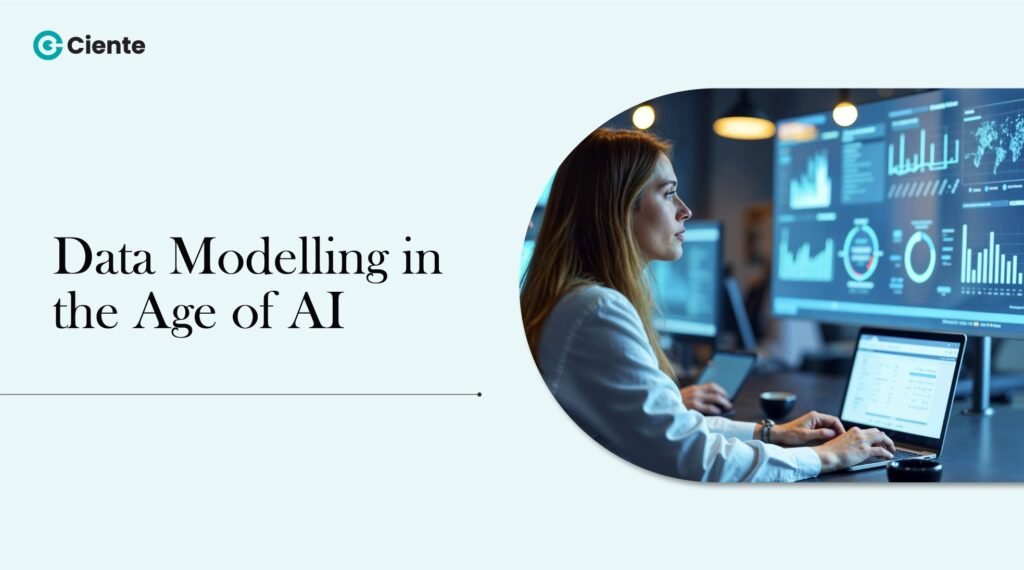Organizations often struggle to eliminate biases in their data or find meaningful connections. However, there is a great solution. One powered by AI.
Design systems are one of the greatest discoveries in technology. These systems help us draw insights from the world and use them to our advantage— this is called data. But it has a flaw.
Even though it is powerful, it can be misunderstood and mismanaged. Often, businesses forget that their data can have deep-rooted biases or they fail to organize it in meaningful ways.
Data modeling is the solution to all of this, especially AI-powered.
It helps brands make sense of the relationship between data sets and then visualize it.
The visualization of these relationships helps teams understand the underlying meaning of the data and if any bias or duplication exists in it.
And now, with AI in the mix, data modeling won’t just provide visualizations and sorting but give insights that would have gone unnoticed.
The nature of data modeling will change radically, and this is how.
The Foundations of Data Modeling
Traditional Data Modeling Approaches
The classification of data modeling traditionally includes three fundamental types.
Conceptual models establish fundamental connections between data entities in the high-level framework.
Logical models outline data attributes alongside their associated constraints and relationships.
Physical models establish database storage methods through specifications of indexing, partitioning, and storage techniques.
Entity-relationship (ER) models and normalization techniques enable relational databases to preserve data integrity throughout their long-standing industry dominance. The emergence of big data and semi-structured data formats has led to increased adoption of NoSQL databases. NoSQL databases, including key-value stores, document databases, and graph databases, provide superior scalability and adaptability for managing extensive and varied data sets.
Challenges in Traditional Data Modeling
Traditional data modeling faces several hurdles:
• Scalability Issues: Traditional relational models face difficulties processing vast unstructured data sets.
• Rigidity: Updating a schema requires manual effort, which makes the process time-intensive.
• Lack of Real-Time Processing: Traditional models fail to dynamically adjust to new data inputs, making them unsuitable for AI-based application needs.
The shift toward AI-based data strategies intensifies these limitations, creating opportunities for AI-powered solutions.
AI-Powered Data Modeling: A Paradigm Shift
How AI is Transforming Data Modeling
AI enhances data modeling capabilities through automation integrated with intelligent systems.
• Automating Schema Generation: AI models automatically generate optimized schemas by analyzing datasets and identifying usage patterns and data structures.
• AI-Driven Data Integration: Machine learning algorithms identify connections between different datasets to enable smooth data integration.
• Real-Time, Adaptive Modeling: AI facilitates real-time database evolution through dynamic schema adjustments that respond to ongoing data changes.
These technological developments minimize human input while boosting the efficiency and accuracy of data processing operations.
Examples of AI in Data Modeling
Several practical implementations demonstrate how AI transforms data modeling.
• Google AutoML Tables: AI automates predictive model creation and requires little human intervention.
• AI in Knowledge Graphs: Data relationships in graph-based models are enhanced through AI-driven entity resolution techniques.
• Financial Risk Modeling: The banking industry benefits from AI through improved fraud detection systems and predictive analytics capabilities.
The examples demonstrate how AI enhances data models by boosting their accuracy and scalability while maintaining efficient performance.
Key Techniques in AI-Driven Data Modeling
Neural Networks for Data Structuring
Neural networks process large unstructured datasets and extract patterns that remain undetected by conventional modeling methods. The use of AI for data structuring minimizes human intervention while improving data precision.
Graph-Based Data Modeling
AI is utilized by graph databases to dynamically enhance data relationship optimization. Knowledge graphs powered by AI technology improve search functions while boosting recommendation systems and enterprise knowledge management operations.
Reinforcement Learning for Data Optimization
The application of reinforcement learning enables databases to improve query performance along with storage strategies and indexing methods. AI models enhance data structure performance through continuous learning from query patterns.
The Business Impact of AI-Driven Data Modeling
Enhanced Decision-Making
AI-driven data models enable organizations to gain deeper insights and accelerate analytics processes, which supports more accurate data-driven decision-making.
Efficiency and Automation
Automation of data structuring processes eliminates manual intervention while enhancing data uniformity and speeding up analytical insights, benefiting sectors such as healthcare and finance along with e-commerce.
Scalability for Big Data
AI-driven models maintain performance and data integrity while processing massive amounts of fast-moving data to support business scalability.
Challenges and Ethical Considerations
Bias in AI Data Modeling
AI models adopt biases in training datasets, resulting in distorted predictive outputs and decision processes. To mitigate AI bias, organizations must select appropriate datasets while maintaining ongoing audits of their models.
Data Privacy & Compliance
AI-driven models have to adhere to data protection rules such as GDPR and CCPA to maintain proper data governance standards.
The Black Box Problem
The decision-making processes of AI-generated models remain opaque because these models often operate without transparency. Building trust in AI-driven data modeling requires the implementation of explainability techniques.
Future Trends in AI and Data Modeling
Self-Adaptive Data Models
AI-driven models will progressively develop autonomous capabilities to dynamically alter their structures as new real-time data becomes available.
AI-Generated Databases
Self-healing autonomous databases will operate with minimal human involvement while automatically optimizing performance.
AI-Augmented Data Governance
AI technology becomes essential for maintaining data security and integrity while ensuring compliance standards, leading to more dependable and efficient data governance.
The Role of AI in Data Security
AI-Powered Threat Detection
Organizations use AI models more frequently to identify cyber threats and detect anomalies. Through data access pattern analysis, AI systems can detect unauthorized activities and prevent risk escalation.
Encryption and Data Masking with AI
Data security is strengthened by AI-driven encryption algorithms that protect sensitive information yet allow analytical access in controlled environments.
AI in Compliance Monitoring
AI systems maintain organizational compliance with changing regulations by monitoring data usage in real-time and marking any usage that breaches regulatory standards.
Data Modeling Will Reach New Heights Through Human-AI Cooperation
Augmented Intelligence, Not Replacement
AI systems will enhance human data architects’ skills rather than replace them. AI-powered automation of routine tasks enables professionals to dedicate their efforts to strategic decisions, which creates a mutually beneficial collaboration between humans and AI systems.
The Need for AI Governance
The integration of AI into data modeling requires the establishment of governance frameworks. It is essential for organizations to establish ethical policies regarding AI use that guarantee transparency while maintaining fairness and accountability.
Upskilling for the AI Era
Data professionals need to engage in lifelong learning to fully utilize AI capabilities. Staying competitive within the changing business environment requires mastering AI-driven data modeling techniques.
AI in Data Quality Management
Automated Data Cleaning
Through automatic error detection and correction of inconsistencies and missing values, AI achieves higher data quality, leading to cleaner datasets suitable for analysis and decision-making.
AI-Driven Data Validation
Through anomaly detection and correction recommendations, machine learning algorithms enhance data reliability by ensuring accuracy and consistency.
Predictive Data Quality Monitoring
The AI system monitors data streams around the clock to forecast quality issues and generate proactive solutions for those problems.
AI-Enhanced Data Visualization
Intelligent Data Summarization
Stakeholders can easily extract insights from large datasets because AI-powered tools create meaningful summaries without requiring users to manually process extensive amounts of data.
Adaptive Dashboards
Artificial Intelligence technology adapts data visualization elements according to user activity and specific requirements to deliver reports that are both relevant and personalized.
AI-Driven Storytelling with Data
Natural language processing (NLP) allows AI to turn raw data into understandable stories, which helps users access and use insights more effectively.
Conclusion
AI brings a fundamental transformation to data modeling by enhancing its efficiency and intelligence while enabling scalability. The implementation of AI-driven data models positions businesses for superior performance in analytics capabilities alongside improved decision-making and innovative processes. The evolution of AI will lead to expanded possibilities for data optimization and utilization.
During this period, data functions as the new oil while AI becomes the refinery that converts raw data into valuable business insights.



